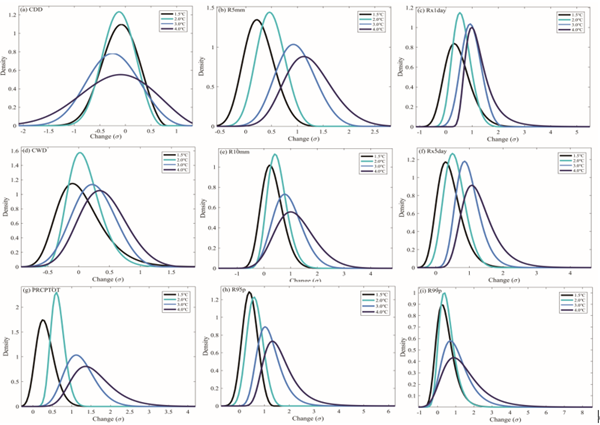Research Reveals Characteristics of Extreme Precipitation Changes in the Tienshan Moutain, Central Asia under Different Warming Scenarios
2022-09-05
The Sixth IPCC Assessment Report notes that observed global mean surface temperatures has increased at an unprecedented rate for at least the past 2000 years. Compared with 1850–1900, it has risen 1.09°C as of 2011–2020 and even reached 1.26°C in 2020. The increase in extreme precipitation is closely related to the change in global temperature. Significant increases in the intensity, frequency and total amount of heavy precipitation events have been observed in most regions of the globe since the 1950s and are expected to intensify further in the future. Studies suggest that future rates of increase in extreme precipitation could even be as high as 14%/°C, far exceeding the theoretical value of the atmospheric water holding capacity proposed by Clausius-Claperon (7%/°C). Extreme precipitation events, as a category of sudden and widespread events, often lead to floods, landslides, mudslides, and other natural hazards, making natural and socio-economic systems extremely sensitive and vulnerable to their changes. However, few studies have focused on extreme precipitation variation in the Tienshan Mountain, Central Asia, and on changes in extreme precipitation reduced by limiting global warming levels.
Researchers from Xinjiang Institute of Ecology and Geography, Chinese Academy of Sciences, investigated changes in extreme precipitation over the Tienshan Mountain, Central Asia under different levels of global warming (1.5°C, 2.0°C, 3.0°C, and 4.0°C) based on the downscaled and bias-corrected state-of-art global climate models from the Coupled Model Intercomparison Project Phase 6 (CMIP6). In particular, the study focuses on the robustness of changes and the benefits of limiting warming to 2.0 °C as opposed to 3.0 °C.
The results show that the frequency and intensity of extreme precipitation in the Tienshan Mountain, Central Asian is expected to change strongly for all warming levels compared with the reference period (1976–2005), and that the proportion of areas with robust changes in extreme precipitation increases with warming levels. An additional 1.0°C of warming compared to 2.0°C does have a significant impact, especially for more intensified extreme precipitation indices. In terms of avoided impact, the lower level of warming (2°C compared to 3°C) avoided 62.84% to 153.77% of the impacts associated with changes in the frequency, intensity, and duration of extreme precipitation.
The results were published as "Future changes in extreme precipitation from 1.0 °C more warming in the Tienshan Mountains, Central Asia" in Journal of Hydrology.
Article link:https://authors.elsevier.com/c/1fWQa52cuXX1R

Fig. 1 Changes in the CDD, R5mm and Rx1day in the TMCA at different warming levels (1.5 °C, 2.0 °C, 3.0 °C, and 4.0 °C) compared to 1976–2005. Areas with statistically significant changes are marked with black dots (RGB [0,0,0]). Area with a signal-to-noise ratio greater than or equal to 1 are marked with cardinal red dots (RGB [178,24,43]), while those where more than 80 % of the members agreed to the signs of the changes are marked with burgundy dots (RGB [103,0,31]). (For interpretation of the references to colour in this figure legend, the reader is referred to the web version of this article.)

Fig. 2 Probability distribution functions (PDF) for multi-model ensemble median change results, compared to 1976–2005, in (a) CDD, (b) R5mm, (c) Rx1day, (d) CWD, (e) R10mm, (f) Rx5day, (g) PRCPTOT, (h) R95p, and (i) R99p across the Tienshan Mountains under 1.5 °C (black), 2.0 °C (light blue), 3.0 °C (blue), and 4.0 °C (dark blue) warming. These change results are normalized by the standard deviation (σ) of the time series over the reference period (1976–2005). (For interpretation of the references to colour in this figure legend, the reader is referred to the web version of this article.)
Contact: LIU Jie, Xinjiang Institute of Ecology and Geography
E-mail: liujie@ms.xjb.ac.cn



